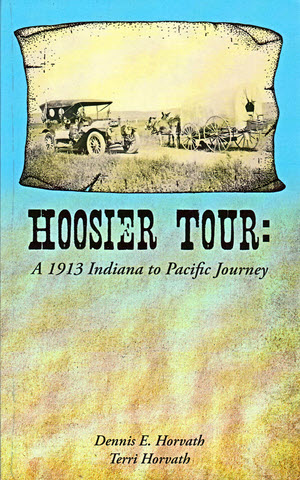 Carl Fisher was a busy man in 1913. His Prest-O-Lite Company and his automobile dealership were both going great guns, the Indianapolis Motor Speedway he co-founded looked like it might amount to something, the Ocean-to-Ocean Rock Highway he had proposed in September of 1912 was taking off, and then there was the Indiana Automobile Manufacturers’ Association.
Carl Fisher was a busy man in 1913. His Prest-O-Lite Company and his automobile dealership were both going great guns, the Indianapolis Motor Speedway he co-founded looked like it might amount to something, the Ocean-to-Ocean Rock Highway he had proposed in September of 1912 was taking off, and then there was the Indiana Automobile Manufacturers’ Association.
In the early years of the industry, Indiana was second only to Michigan in number of automobile manufacturers. Several of them cooperated in a 1911 four state promotional tour that was so successful they organized the IAMA and another four state tour in 1912. In 1913 they were ready for something bigger. The result was the Indiana-Pacific Tour that went from Indianapolis to San Francisco then down the coast to end at Los Angeles. Carl Fisher was part of the tour that left Indianapolis on July 1, 1913, the same day that the Lincoln Highway Association, which is what his Rock Highway proposal had led to, was incorporated. That coincidence of dates and a connection with the troublesome Colorado loop of the Lincoln Highway were essentially the only details of the IAMA tour I knew of. Now, thanks to Dennis and Terri Horvath, I know a lot more.
Hoosier Tour: A 1913 Indiana to Pacific Journey is not filled with flowery prose or lots of humor. That’s not how the Horvaths write. Neither is it filled with terse sentences and clipped descriptions. It is filled with an enjoyable and accurate account of the complete tour and the lead up to it. It tells of the men and machines on the tour and gives a hint of the tour’s impact on the acceptance of automobiles and the Good Roads Movement.
After a couple of chapters describing the IAMA and its planning for the tour, Hoosier Tour follows the Indiana vehicles across the country. Though not organized as such, the book is something of a group diary in that a day’s beginning and end points are usually mentioned along with highlights and lowlights.
This was a huge event in its day. It included eighteen cars and two trucks from fourteen manufacturers. Several journalists and a former Indianapolis mayor rode along. One car was driven by the winner of the inaugural Indianapolis 500, Ray Harroun. Several governors climbed aboard when the tour entered their state and rode along until it exited. Virtually every cluster of building on the route demanded a visit and presented the participants with gifts ranging from watermelons to free gas.
As an advertisement for Indiana built automobiles, the tour was a complete success. Not one car dropped out for mechanical reasons. It also performed well in regards to another stated purpose, boosting the Good Roads Movement. Aside from the high profile tour raising awareness considerably, it triggered improvement along the route it followed. Every locale wanted to make a good impression and the book tells of many improvements made just days ahead of the tour’s arrival.
One reason to impress was the belief, held by many, that Fisher was using the tour to evaluate the intended route of the Lincoln Highway. He denied any official connection between the route of the Indiana-Pacific Tour and the Lincoln Highway and much of the tour route was not even close to the path that would be announced in September but the belief was not totally without merit. Those familiar with Lincoln Highway history may know that the highway, as originally announced, did not enter Colorado but that a “Colorado Loop” was quickly added in response to pressure from the state. After reading the Horvaths’ account of the tour’s visit to Denver, which included a parade and a real brass band, it is rather easy to see why Colorado had expectations.
Even though the Indiana-Pacific Tour would continue on to Los Angeles, reaching San Francisco made good the title and there were great celebrations. A parade greeted them on arrival though the Horvaths do not say whether or not it included another brass band. Banquets, tours of the recently rebuilt city, and a stop at Cliff House kept the tourists busy for about three days. The book follows them down the coast to Los Angeles where most of the tourists boarded a train for the trip home. With the tourists back in Indianapolis, the final chapter touches on what followed for the Indiana automotive industry. Next are several pages of photos from the tour and appendices listing the tour’s people and vehicles.
There is little question that the Indiana-Pacific Tour should be better known than it is. It demonstrated the ability of automobiles, particularly Indiana built automobiles, to travel long distances and it brought nationwide attention to the value of good roads. It deserves to be more than a footnote to the Lincoln Highway and this book should help with that.
A lot has changed in one hundred years. It is a little sad that we can no longer purchase an Indiana built Stutz Bearcat but it is a good thing that we no longer have to dodge thrown ears of corn as the driver of the Stutz on the tour had to do after frightening a farmer’s horses.
Hoosier Tour: A 1913 Indiana to Pacific Journey, Dennis E. Horvath and Terri Horvath, AGG Publishing, 2013, paperback, 5 x 8 inches, 114 pages, ISBN 978-1490403267
Available through Amazon.

Outstanding! This is definitely going on my reading list.
Your state has a lot of automotive history and Dennis Horvath knows most of it.